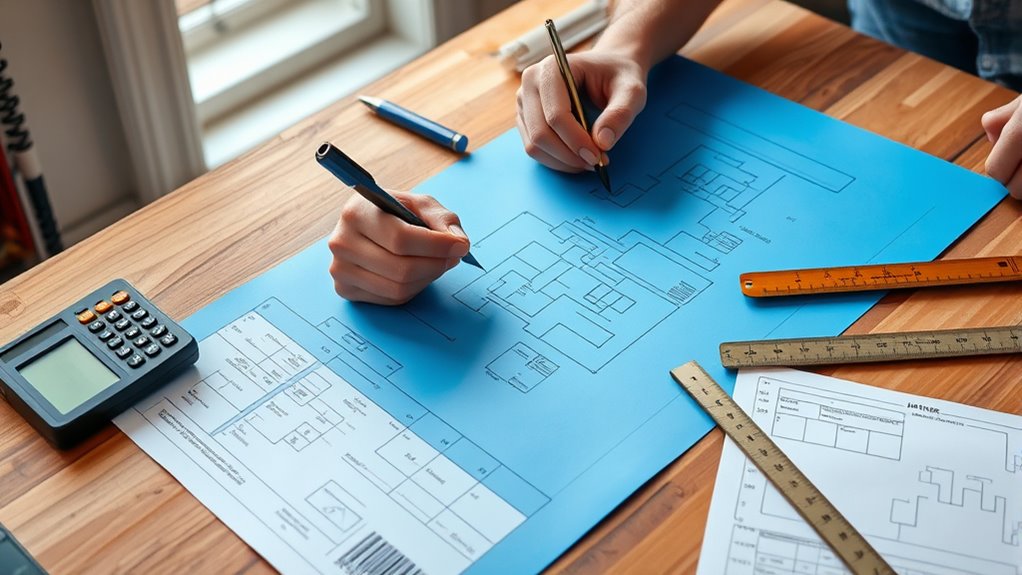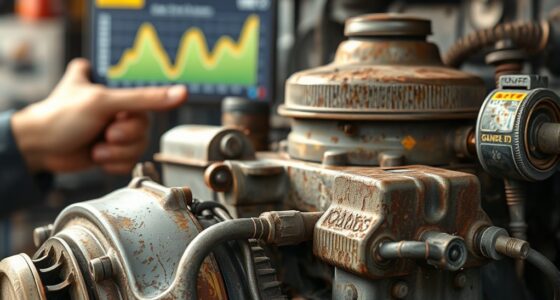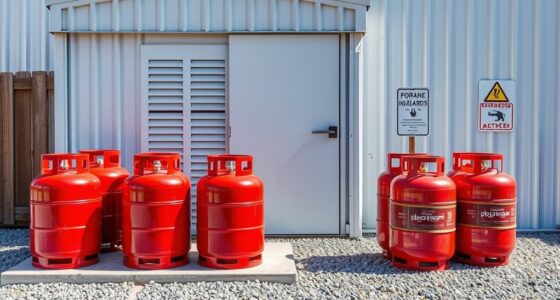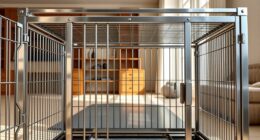Accurate sizing for heat pumps and well pumps relies on thorough load calculations that consider your home’s insulation, window size, climate, and water demand. Skipping these steps can lead to inefficient operation, higher costs, or equipment failure. Using proven methods like Manual J for heat loads or detailed flow assessments for well pumps ensures you match capacity with actual needs. Keep exploring further steps to guarantee your system runs reliably and efficiently.
Key Takeaways
- Perform detailed load calculations using tools like Manual J to match heat pump capacity with building-specific heating and cooling needs.
- Consider climate variables, insulation quality, and building features to accurately determine required system size.
- Include all internal and external loads, such as occupants, appliances, and outdoor features, in well pump demand assessments.
- Avoid simplistic rules of thumb; rely on professional assessments and site-specific data for precise sizing.
- Properly size both heat and well pumps to prevent inefficiencies, short cycling, or excessive wear, ensuring system longevity.
Understanding the Basic Principles of Heat Pump Sizing
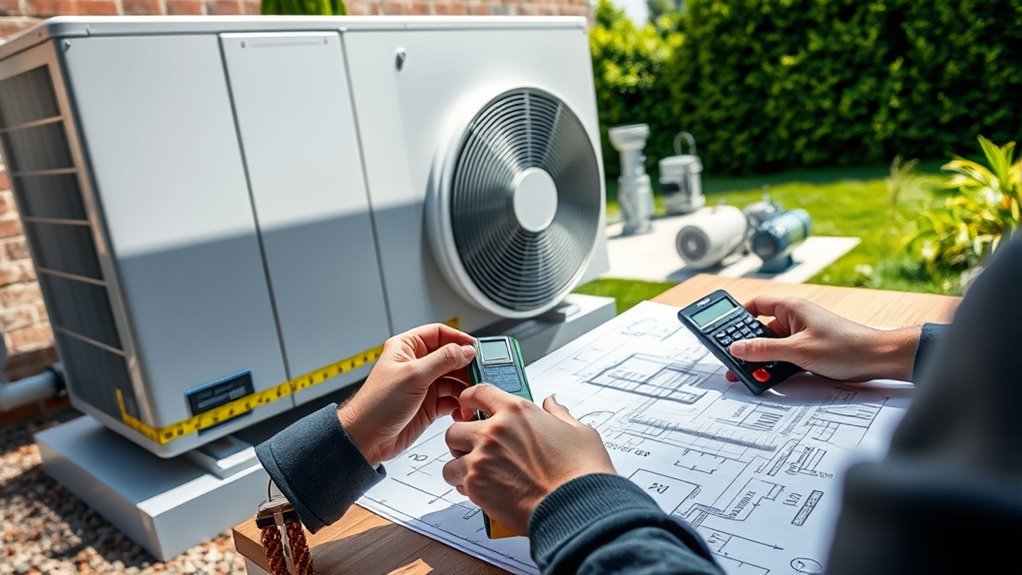
Understanding the basic principles of heat pump sizing is essential to guarantee your system operates efficiently and effectively. Typically, you’ll estimate capacity based on your home’s square footage—about 1 ton (12,000 BTU) per 500 square feet—as a starting point. Keep in mind, this is a rough guide; precise sizing considers factors like insulation, ceiling height, and layout. Avoid oversizing, which causes short cycling, reduces efficiency, and hampers humidity control. Climate and insulation quality also influence capacity needs. Proper sizing involves understanding building envelope properties, air leakage, solar gains, and duct losses. Using these principles ensures your heat pump matches your home’s actual heating and cooling loads, preventing inefficiencies and ensuring reliable comfort year-round. Accurately sizing your heat pump requires careful assessment of these variables to optimize performance and energy savings.
How to Accurately Calculate Home Heating and Cooling Loads
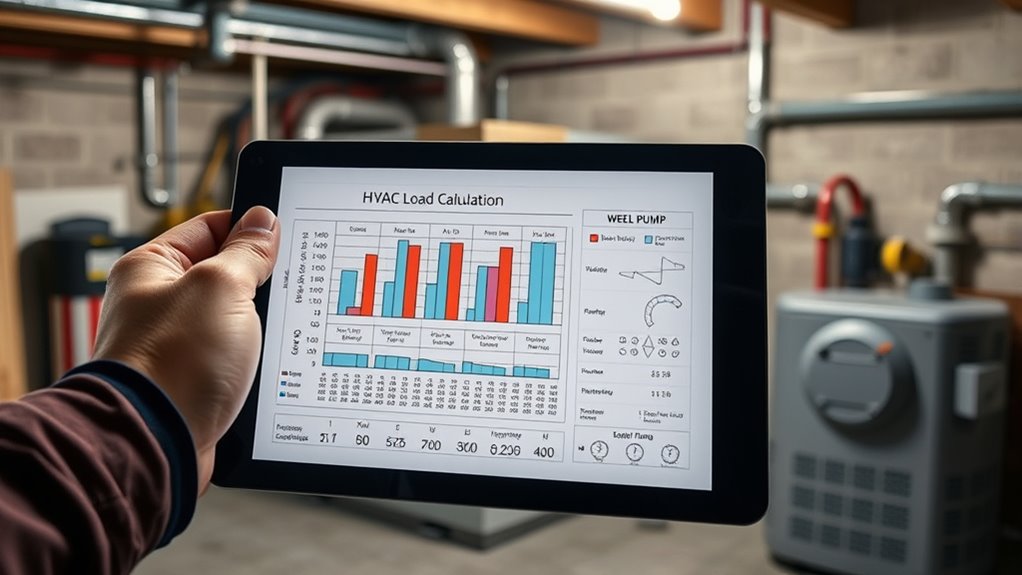
To accurately size your heat pump or well pump, you need to understand the key factors that influence your home’s heating and cooling loads. These include building characteristics, climate variables, and internal gains, which all impact the load calculations. Following a structured process like Manual J helps guarantee your system is properly matched to your home’s specific needs. Properly considering vetted product reviews can also aid in selecting reliable equipment tailored to your requirements.
Essential Load Calculation Factors
Accurate load calculation for home heating and cooling starts with considering a variety of essential factors that influence indoor temperatures. These include climate, building features, internal heat gains, ventilation, and occupancy. Geographic location determines seasonal temperature ranges, humidity, and weather patterns, affecting demand. Building materials, insulation, window size, and orientation impact heat transfer. Internal sources like occupants, appliances, and lighting generate additional heat loads. Ventilation rates and air leakage influence infiltration and exhaust air, altering system size. Occupant behavior and activity schedules cause fluctuations in internal heat gains. Focus on these factors ensures precise sizing, avoiding oversizing or undersizing. Additionally, understanding the color accuracy of your home’s heating and cooling systems can help optimize comfort and efficiency.
Manual J Process Overview
The Manual J process is essential for determining the precise heating and cooling loads of your home, ensuring your HVAC system is properly sized. It involves detailed calculations that take into account various factors to optimize performance and efficiency. To get accurate results, you’ll need to contemplate:
- Room dimensions, insulation, and window details
- Climate data and outdoor temperature variations
- Internal heat gains from occupants, appliances, and lighting
- Specific building features like door types and orientation
- Proper storage conditions are crucial for maintaining the accuracy of load calculations and ensuring the longevity of your HVAC system.
Using either the short or long form, depending on your project, professionals input this data into software tools that perform complex calculations. This process helps avoid common issues like oversizing or undersizing, saving energy, reducing wear, and improving comfort throughout your home.
Impact of Climate Variables
Have you ever wondered how outdoor weather variations impact your home’s heating and cooling needs? Climate affects both sensible and latent heat loads, making accurate calculations essential. Extreme temperatures—hot days over 100°F or cold snaps—significantly increase sensible loads, requiring larger systems. Humidity also plays a role; hot, humid climates raise latent loads, demanding better dehumidification. As climate patterns shift, peak cooling loads rise in southern states, while heating demands decline in many areas. Incorporate local climate data to fine-tune your HVAC system size. Understanding climate variability helps you better anticipate changes in your home’s heating and cooling requirements. Here’s a quick look at climate impacts:
| Climate Variable | Effect on HVAC Loads |
|---|---|
| Extreme temperatures | Increase sensible heat load; larger equipment needed |
| Humidity levels | Affect latent load; impacts moisture control requirements |
| Climate trends | Shift load patterns, influencing system sizing and efficiency |
Key Factors That Affect the Right Size for Your Heat Pump
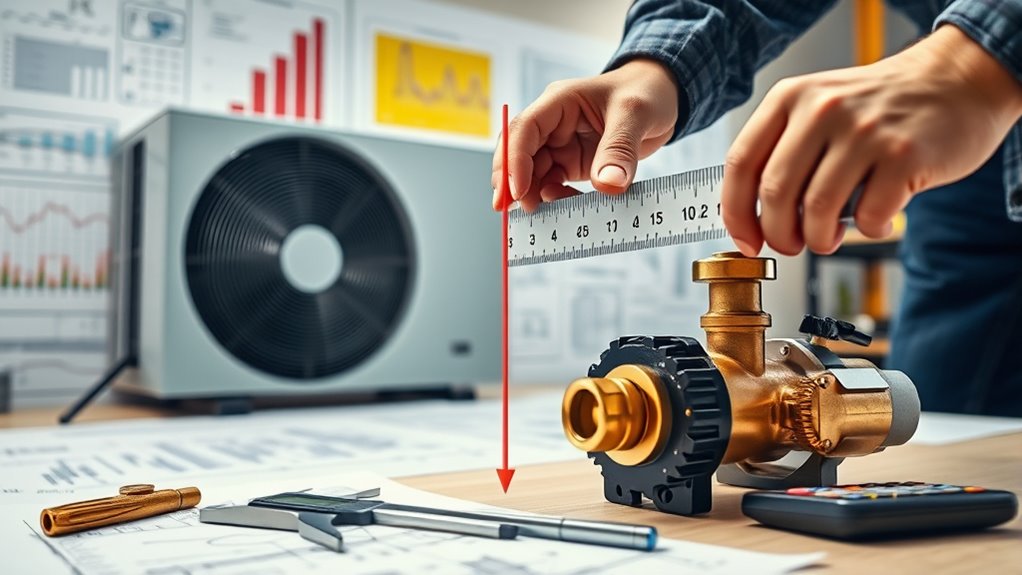
Your home’s insulation quality and local climate play vital roles in determining the right heat pump size. Well-insulated buildings retain heat better and may need smaller units, while colder climates demand larger capacities. Understanding these factors helps guarantee your system provides efficient and reliable comfort year-round. Properly sizing your heat pump is essential to avoid energy waste and ensure optimal performance. Additionally, considering eco-friendly living practices, such as selecting energy-efficient models, can further enhance cost savings and environmental benefits.
Home Insulation Quality
Insulation quality plays a crucial role in determining the right size for your heat pump, as it directly influences how much heat your home retains or loses. Homes with poor insulation demand larger systems to compensate for heat loss, while well-insulated homes need smaller, more efficient units. Upgrading insulation can reduce the capacity needed, saving you money and energy. Factors affecting insulation include:
- Insulation R-value, where higher values mean better resistance to heat flow
- Home age and construction, with older homes often having inferior insulation
- Coverage in walls, attic, floors, and crawl spaces that impacts overall heat retention
- Material type, affecting thermal inertia and insulation effectiveness
- Proper insulation can significantly reduce your heating and cooling costs over time.
Improving insulation not only optimizes heat pump performance but also enhances your home’s comfort and efficiency year-round.
Climate Conditions Effects
Climate conditions directly impact the size and performance of your heat pump. Extreme low temperatures reduce heating capacity, so sizing must account for the coldest expected days. In freezing climates, cold climate heat pumps (ccASHP) are ideal for maintaining efficiency, often supplemented by auxiliary heat during the coldest periods. Warmer regions focus more on cooling loads, requiring different sizing priorities. Humidity levels also matter: high humidity demands units capable of handling latent cooling loads and moisture removal, while low humidity areas prioritize sensible cooling. Climate zones and local weather patterns influence performance standards, auxiliary heating needs, and capacity adjustments. Wide temperature swings and seasonal variability increase demand fluctuations, so your heat pump needs flexibility. Proper sizing considers these factors to make certain reliable, energy-efficient operation year-round. Additionally, considering local portable power sources can help ensure consistent operation in remote or off-grid locations.
Step-by-Step Guide to Determining Well Pump Capacity

Determining the right well pump capacity starts with understanding your household’s peak water demands. You need to calculate the maximum flow rate your system requires during busy periods, not average use. Use fixture count methods—each fixture roughly equals 1 GPM (e.g., 12 fixtures = 12 GPM)—or assess water usage during peak intervals like a 7-minute shower. Remember to include outdoor features such as irrigation, pools, or hot tubs that add to demand. Accurately sizing your well pump is crucial to prevent underperformance or excessive wear, so careful calculations are essential. Additionally, consider the well’s capacity and static head to ensure your pump can handle the required lift and flow rates efficiently.
Common Mistakes in Sizing and How to Avoid Them
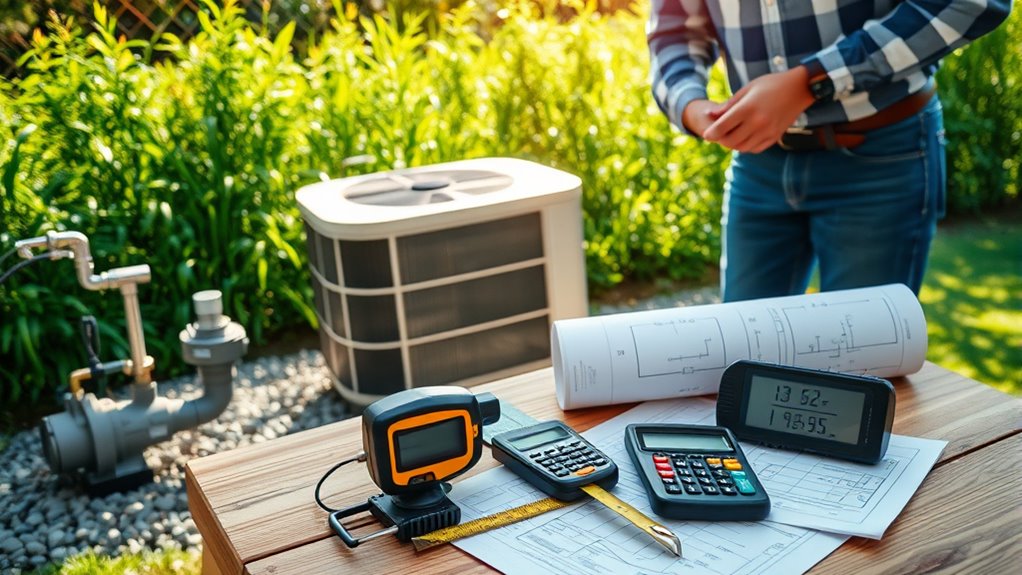
Many common mistakes in sizing heat pumps stem from relying on simplistic rules of thumb or skipping detailed calculations. Using fixed BTU per square foot estimates often leads to oversizing or undersizing, which causes poor efficiency, discomfort, and equipment wear. Oversized units short cycle, increasing noise, reducing lifespan, and impairing dehumidification. Undersized units run constantly, wasting energy and failing to meet heating needs, especially in colder weather. Ignoring professional load calculations—like Manual J—ignores critical factors such as insulation, air leakage, and climate, resulting in inaccurate sizing. Many rely on outdated or overly simple methods, risking costly mistakes. Properly performed, manual J calculations ensure that the system is accurately matched to the home’s specific needs, avoiding the pitfalls of oversimplification. To avoid these pitfalls, always perform thorough, site-specific assessments and adhere to standards like DIN EN 12831 for accurate heat load calculations. Additionally, considering building insulation quality can significantly impact the sizing accuracy, preventing common errors.
Practical Tips for Ensuring Optimal Pump and System Performance
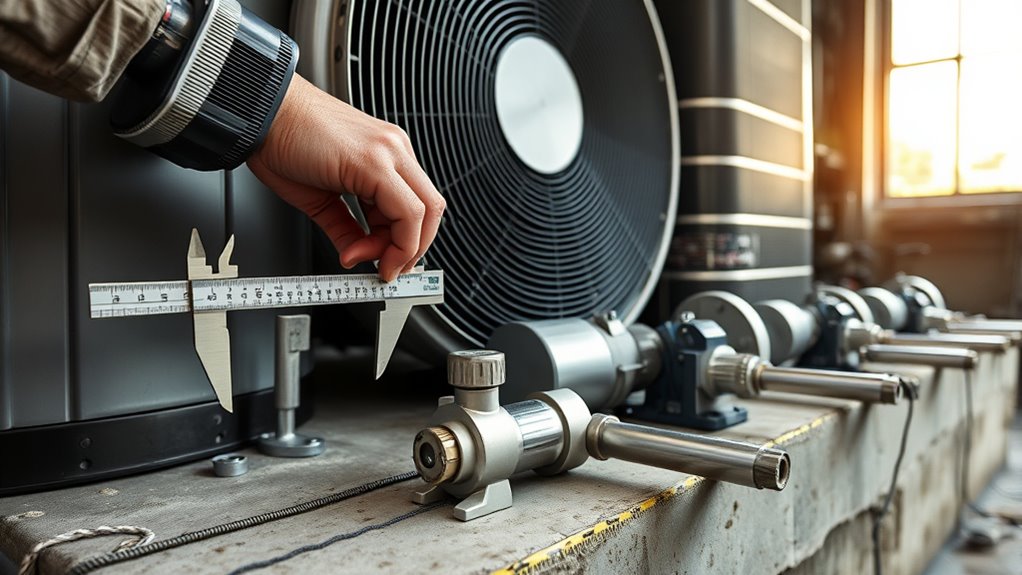
To guarantee your heat pump and well pump operate at their best, accurate load calculation is essential. It ensures proper sizing, preventing inefficiency and discomfort. To optimize system performance, consider these practical tips:
- Use Manual J or equivalent software rather than relying solely on square footage.
- Include factors like ceiling height, insulation, window efficiency, air leakage, and occupancy.
- Conduct blower door tests to measure infiltration and refine load estimates.
- Consult professionals for detailed assessments, including duct leakage tests and site inspections.
- Remember that quality assessment is vital to determine the appropriate pump size and system capacity, ensuring longevity and efficiency.
Frequently Asked Questions
How Often Should I Re-Evaluate My Heat Pump’s Size?
You should re-evaluate your heat pump’s size at least every 3-5 years or whenever major home changes occur, such as renovations or improved insulation. Keep an eye on operational signs like short cycling, extended runtimes, or increased energy bills. Regularly monitor your system’s performance and conduct blower door tests after upgrades to guarantee your heat pump still meets your home’s heating and cooling needs efficiently.
Can I Size a Heat Pump Based Solely on Square Footage?
Think of your home as a unique puzzle, with each piece—insulation, climate, windows—contributing to the whole picture. You can’t accurately size a heat pump based solely on square footage. Relying only on size is like trying to complete a puzzle with missing pieces—it leads to errors, inefficiency, and discomfort. Instead, use a detailed Manual J calculation, considering all factors for a perfect fit.
What Are Signs My Well Pump Is Undersized?
You’ll notice your well pump is undersized if you experience frequent low water pressure, especially during peak usage. If your pump runs constantly or struggles to deliver enough water, it’s a sign it can’t keep up. Additionally, sputtering faucets, air in the lines, or inconsistent flow indicate your pump isn’t meeting your household’s demands. These issues suggest upgrading to a larger pump will improve performance and water availability.
How Does Climate Change Impact Pump Sizing Calculations?
Climate change impacts your pump sizing calculations by altering groundwater temperatures, water demand, and availability. You need to account for lower static water levels during droughts, which demand pumps with higher head capacity. Increased temperature variability and extreme weather mean you should utilize dynamic models rather than static ones. Regular reassessment guarantees your pump remains efficient and capable of handling changing conditions, preventing undersizing or oversizing issues.
Are Multi-Stage Heat Pumps More Cost-Effective Long-Term?
You’ll find that multi-stage heat pumps are more cost-effective in the long run, often saving you money through lower energy bills. They transfer up to 450% of the energy they consume, making them highly efficient. Although they cost more upfront—up to 80% more—they reduce wear and tear, extend lifespan, and qualify for rebates, which can offset initial costs. Over time, these benefits make them a smarter investment.
Conclusion
Getting your heat pump and well pump sizes right isn’t just about numbers; it’s about aligning your home’s unique needs with precise calculations. When you pay attention to these details, you might find that the perfect fit comes together when you least expect it—almost as if the universe conspired to bring everything into balance. Trust these steps, and you’ll enjoy efficient performance and peace of mind, proving that good planning often leads to surprisingly seamless results.

